I’ll admit right away that my previous encounters with Gustard DACs didn’t make me a fan of the brand, but their latest R26 definitely changes that. I believe that R26 is the first R2R DAC entry from Gustard and I can spoil this review just a bit by saying it’s a stunning one. Keep reading to find out why.
Build and Connectivity
Thinking about an average DAC on the market nowadays I can say that R26 is quite a chunky one, with a considerable weight too. Looks are subjective, and I’ll leave that to you, but the build quality is top-notch. It’s made of thick aluminium and truly built like a tank. The front panel hosts a modestly sized monochromatic display that serves its purpose well. You can easily see selected input and volume level, but you’ll have to get out of the couch to navigate the menus. The menu part is usually done during the initial device setup and when we get to know the unit and its features. Once that period is over and we settle on our favorite setting, I don’t think that most people will tinker with it anymore. So this should not be a problem in everyday use, at least it isn’t for me.
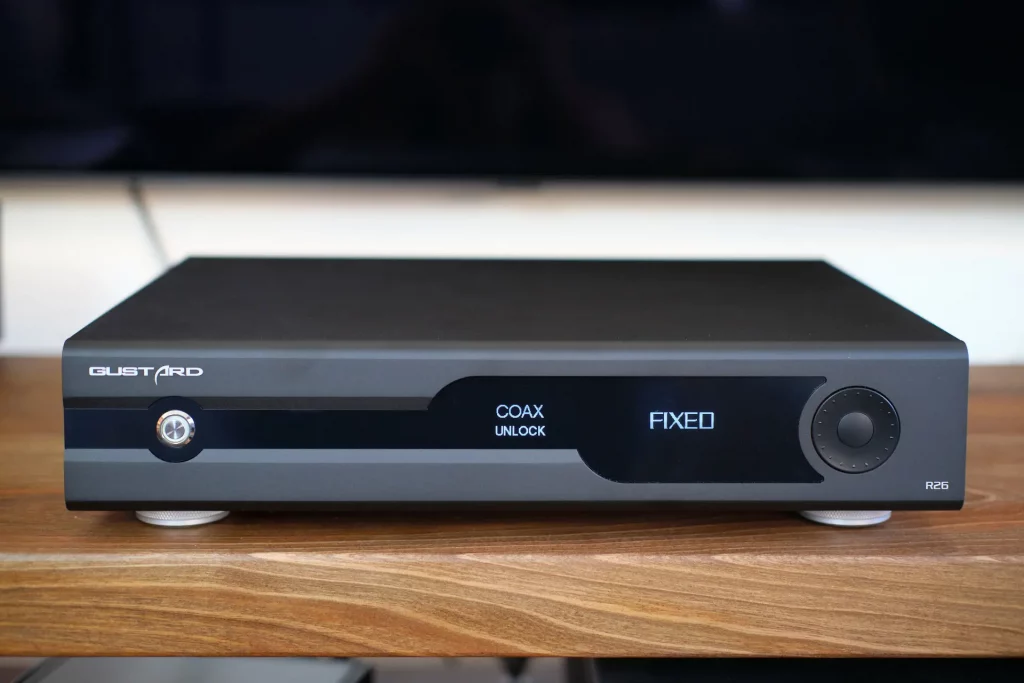
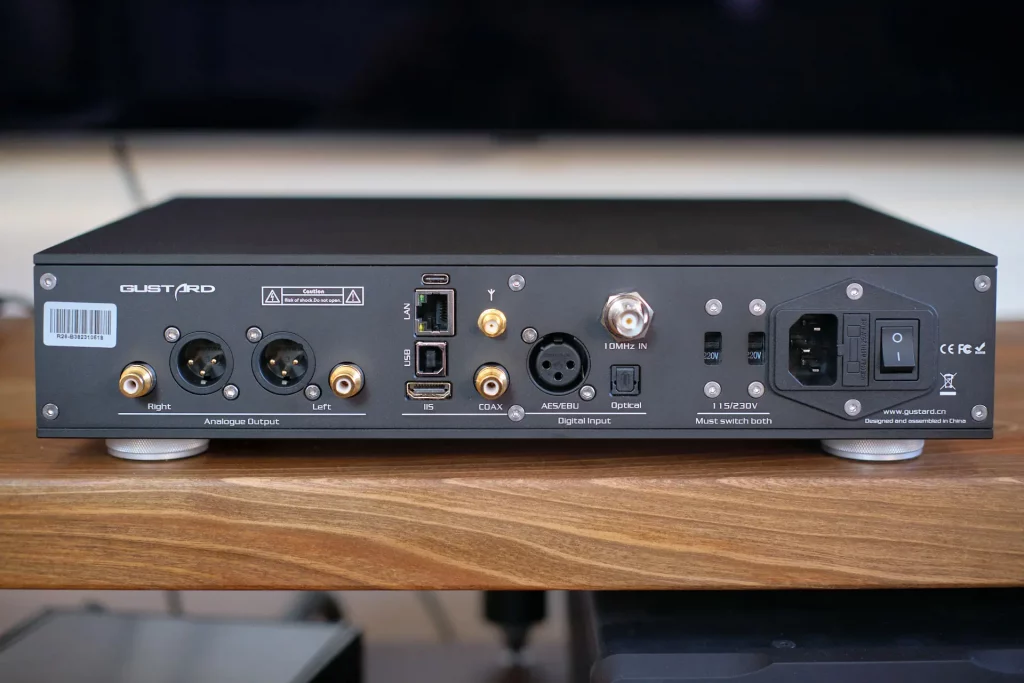
The back of the unit is where things actually get interesting. Let’s start with analog outputs because that’s a shorter list. We have both single-ended RCA outs and balanced XLR outs to choose from. Both of these can be used as fixed-level outs or with volume attenuation. When it comes to digital inputs, Gustard provided a very rich selection. Usuals like USB, Coax SPDIF, and Optical Toslink are all present. Less common AES/EBU and IIS are also onboard, but probably the most uncommon input is an Ethernet port marked LAN. The LAN port is here to enable audio streaming directly from your network over UPnP or Roon protocol, where other device such as a PC or phone is used to send the audio stream through the network and R26 acts as an audio renderer.
Internals
I will be short and to the point in this section since my whole reviewing philosophy centers around the end result and not the underlying technology that helps get there. So let’s do this quickly. Instead of using some of the famed DAC chips, Gustard R26 relies on a resistor ladder network to conduct D/A conversion. This is joined by XMOS signal processor, a precise Clock synthesizer, two toroidal transformers to power digital and analog sections of the DAC separately, high-quality power filtering, etc. You can find a long list with bells and whistles on the manufacturer’s webpage so there’s no need for me to retype it here. You got the gist – a lot of care and attention went into making this DAC and one look inside the unit confirms that.
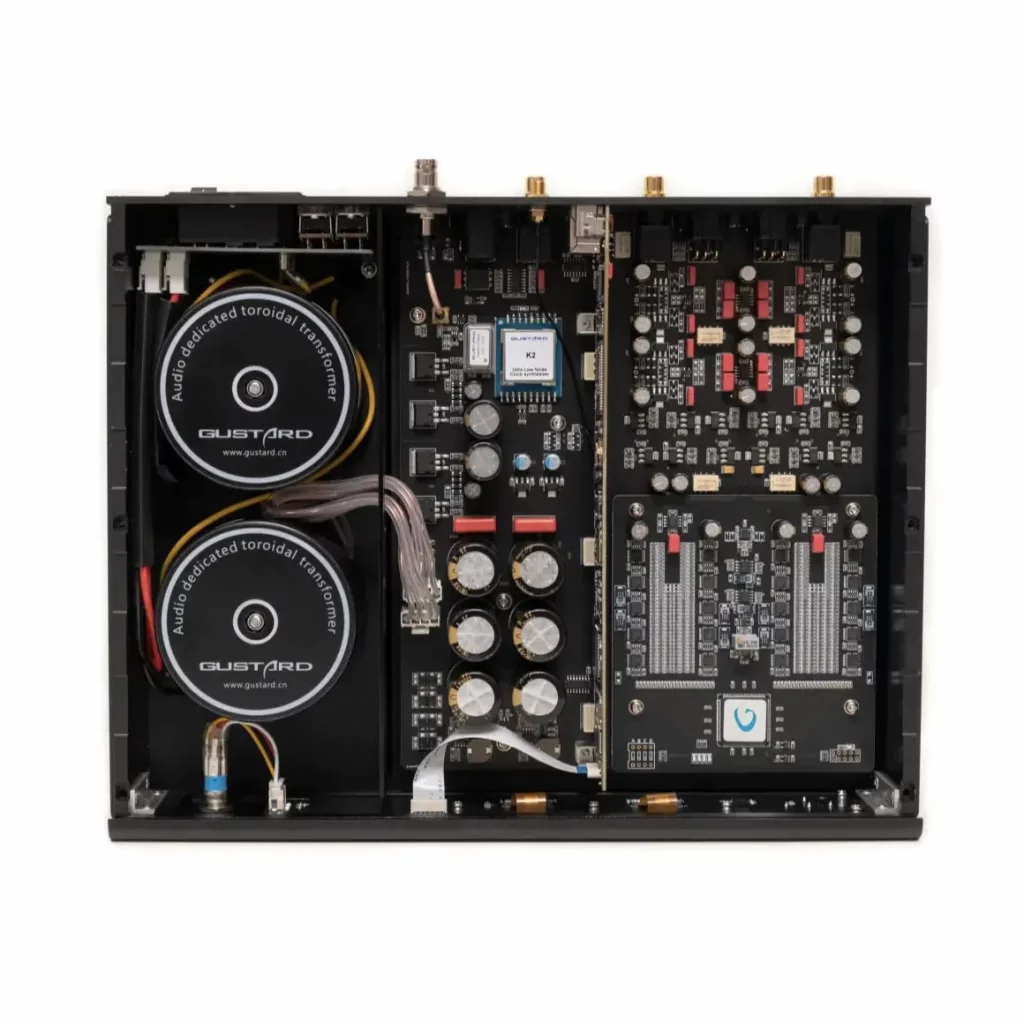
Modes of operation
No matter how you feed your R26, you’ll have the option between two modes of operation OS (OverSampling) and NOS (Non-OverSampling). As for digital filters, there are “only” three of them: fast, medium, and slow. Now I won’t spend much time talking about the subtle differences that these combinations bring because you can try that for yourself. I’ll only say that I personally preferred the OS mode of operation with the medium filter. I found it offers the best balance between tone timbre and detail retrieval. That said, it’s time to talk about the sound.
Sound (DAC only)
First, I tested Gustard R26 using the external Pi2Design Mercury streamer. R26 offers a very interesting mix of sound qualities. First of all, I noticed that it sounds very clean, fast, and precise – traits that are not often found on R2R DACs of this price. Is this the fastest and most resolving DAC on the market – no it isn’t, but you probably wouldn’t know that unless comparing it directly to the best chip-based Delta Sigma solutions. But let’s keep direct comparisons for later when we come to that section. In isolation, R26 sounds beautifully clean and resolving. Luckily, all that clarity is accompanied by traits that we expect from R2R design too. Overall tonality is full, the tone timbre is rich, and tone edges and transients are resolved in an unforced and natural manner. The bassline is deep, full, and voluminous. It gives a healthy core and body to each tone, that being an instrument or vocal. It’s not the quickest and most grippy bassline out there, but it never feels out of line and like it’s lacking control. It also doesn’t bleed into clean and neutral upper frequencies. Talking about higher frequencies, those are well extended and very clean, but smooth and natural in their nature.
On top of previous traits, Gutard R26 is capable of creating wide and deep soundstage. And when I say this, I don’t think in terms of the price range it belongs to – no, I’m speaking in absolutes this time. This DAC creates a very big and spacious soundstage that deserves that adjective no matter the price we’re talking about. This is true for the soundstage width, but it’s even more true for the depth that’s just impressive. If the rest of your system is up to the task – you’ll hear background instruments and spacial cues coming from far behind your speakers on tracks that are recorded that way. Try “A Trace of Grace” by Michel Godard for example to see what I’m talking about.
Finally, talking about dynamics I can say that Gustard R26 is not a slouch. Big dynamic swings are not a problem. It can also punch and move fast when the track requires it. That said, the best Delta Sigma DACs of the same price will sound even faster-paced, with better microdynamics, and quicker transients, but they will lack many of the qualities mentioned above.
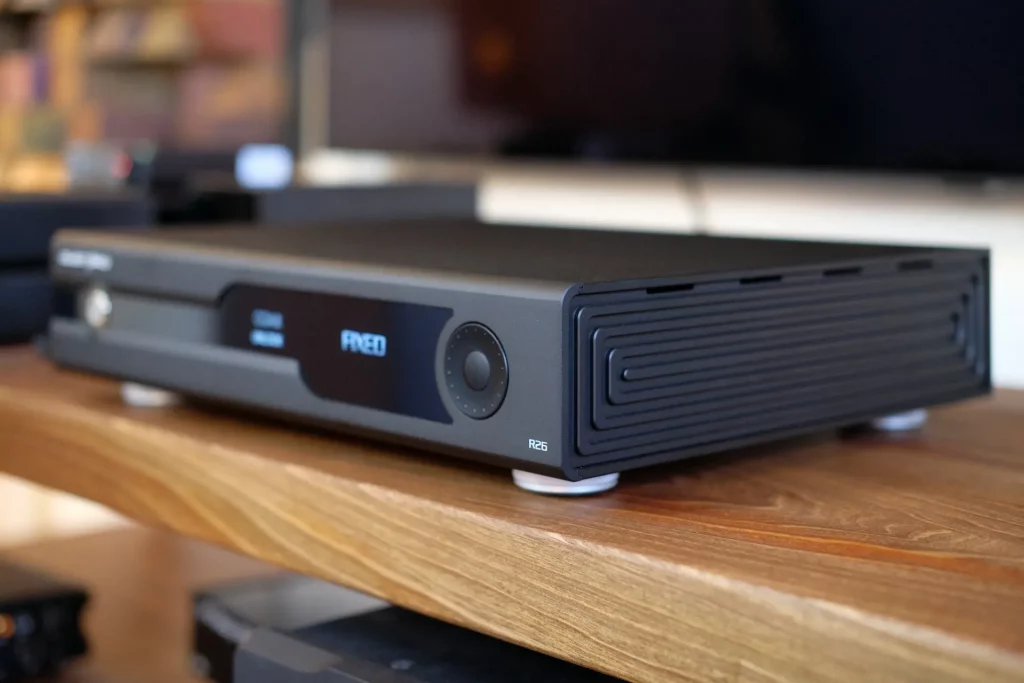
Sound (Streamer/Renderer)
Next, I connected R26 directly to my network using LAN input and streamed some music using UPnP-capable players such as Bubble UPnP on my smartphone. Compared to my dedicated Pi2Design Mercury streamer, this internal solution added an additional layer of clarity. Transients sounded even faster and crisper, while microdynamics improved. That said, some fullness and warmth that I was used to with my own streamer now went away. I can’t say that either solution sounded better than the other, just different. But given that Gustard R26’s integrated solution can go head to head with an external streamer costing $800 that is backed up with a $200 linear power supply, told me a lot.
Another thing to note here is a more practical one. While this solution worked well most of the time, a small hiccup would occur from time to time when I was skipping a song on Tidal or Qobuz streaming service. It would happen only during the first few seconds of a track, the audio would hiccup for a moment and then continue without interruption till the end of the song. Also, if I don’t skip often but listen to a playlist in a row, this wasn’t happening. Now, that looks like a buffering issue that could be solved by a firmware update. Also, I’m not even sure it’s something that would even happen in your own place and with your network.
Comparisons
Chord Qutest offers a deep and spacious soundstage too. However, Chord is lean sounding with a wirey bassline and clean but analytical midrange. R26 has a similarly capable if not bigger soundstage, equally sweet highs, but a much fuller tone timbre, and a more muscly bassline. To my ears, R26 simply sounds more lifelike and doesn’t even need a linear power supply to get there. On top of its sonic supremacy, Gustard offers more features, and better connectivity, and feels like a better package overall.
Ladder Schumann is another R2R DAC of a similar price. This one is much more spartan when it comes to features. It’s just a DAC, with no volume control, no display, and no streamer. On its one, Schumann sounds wonderfully natural and tonally rich, with a big three-dimensional soundstage. In a sense, Schumann sounds more like what I would expect from an R2R design, pros and cons alike. In a direct comparison, Schumann is slightly warmer and richer in the midrange. However, Gustard R26 hits with more clarity, and speed, with a darker background, and an even deeper soundstage. The difference is not huge but it’s there, and it feels like R26 brings some qualities of DS DACs without losing on that R2R magic. So even though I like Ladder Schumann very much and it is one of my favorite DACs that bettered Chord Qutest, Musician Pegasus, and Denafrips Ares II for example, I feel that Gustard has an advantage over it, both sonically and as an overall package due to its long list of features.
Conclusion
To put it short and simple, Gustard R26 is a mighty fine-sounding product and an even mightier value once you consider everything it brings to the table. It’s not only great for the money, it’s just great in absolute terms. If it carried the name of some famed manufacturer and was priced at $3000, it would still get glowing five-star reviews in mainstream media.
| GUSTARD R26 – CHARACTERISTICS |
|
Sample Rate Supported by Digital Input Channels: |
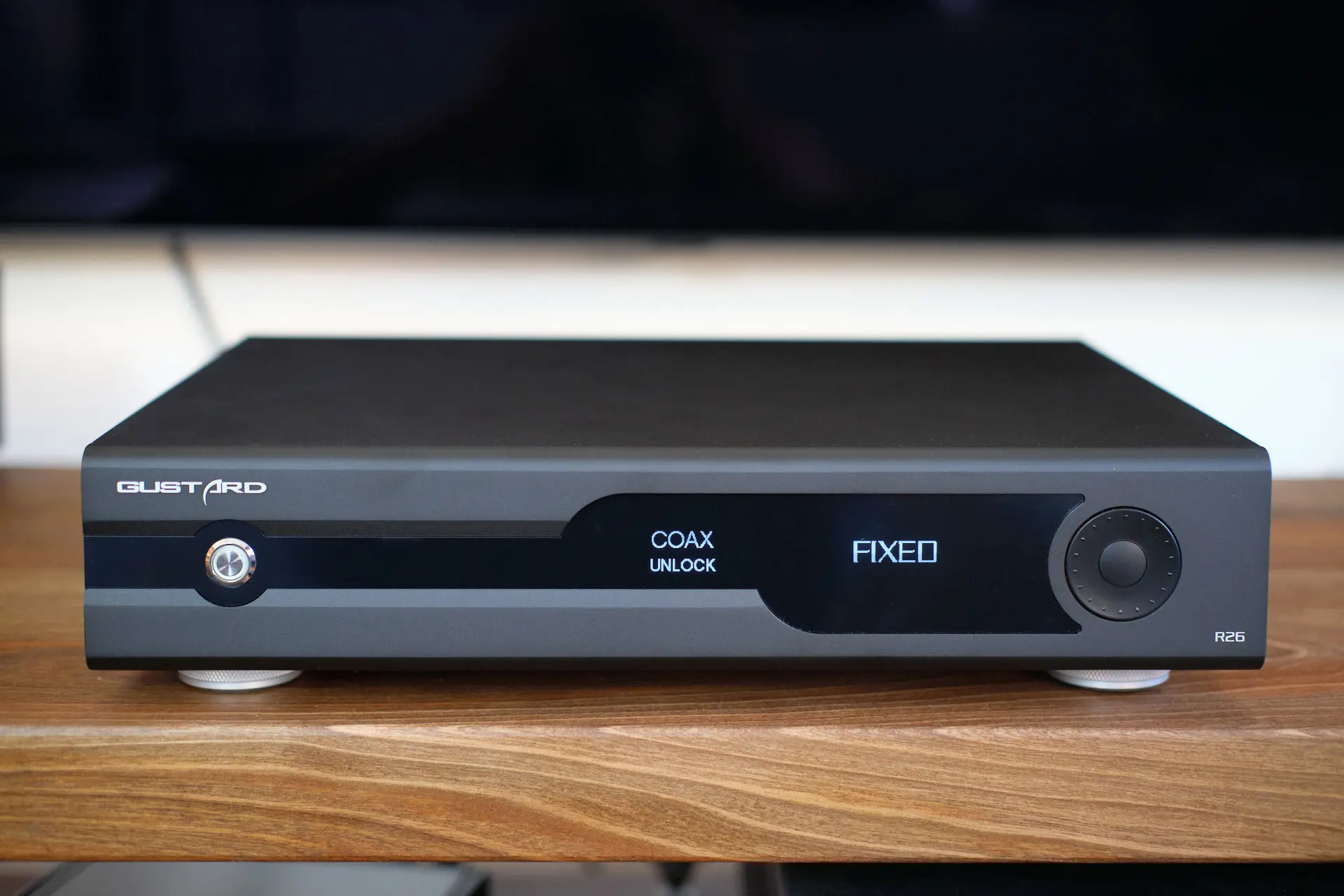





Looks great. Does Gustard make a model like the R26 but which is an R2R DAC only not a DAC and streamer combination? i have a streamer (HiFi Rose).
Not at the moment.
Hi. Thank you for the review! For a large kind of music (rock, electro, classical and music not well recorded) is it better than the A26?
Hi Srboljub,
I see that this is Roon capable. But it’s not stated to be Roon Ready. Do you know if it will allow me to control volume from Roon Remote App? Currently running Node2i and enjoy doing it all from the app. Looking at this to upgrade to a one box and get rid of 2i. Otherwise I might get Ladder Schumann instead and keep Node2i. Thank you for another great review.
The best way to take a little edge off and really make it perfect, is to hook up a tube amp with enough power, like a KT120 tubes/100 watts per channel. This is my setup. I have a Rogue ST 100 and it has much more power than you will ever need to push into the R26. The bass is killer and taut.
How would you compare the Gustard R26 to the Audio GD R8HEMK3?
Haven’t heard Audio GD so I can’t draw that comparison.